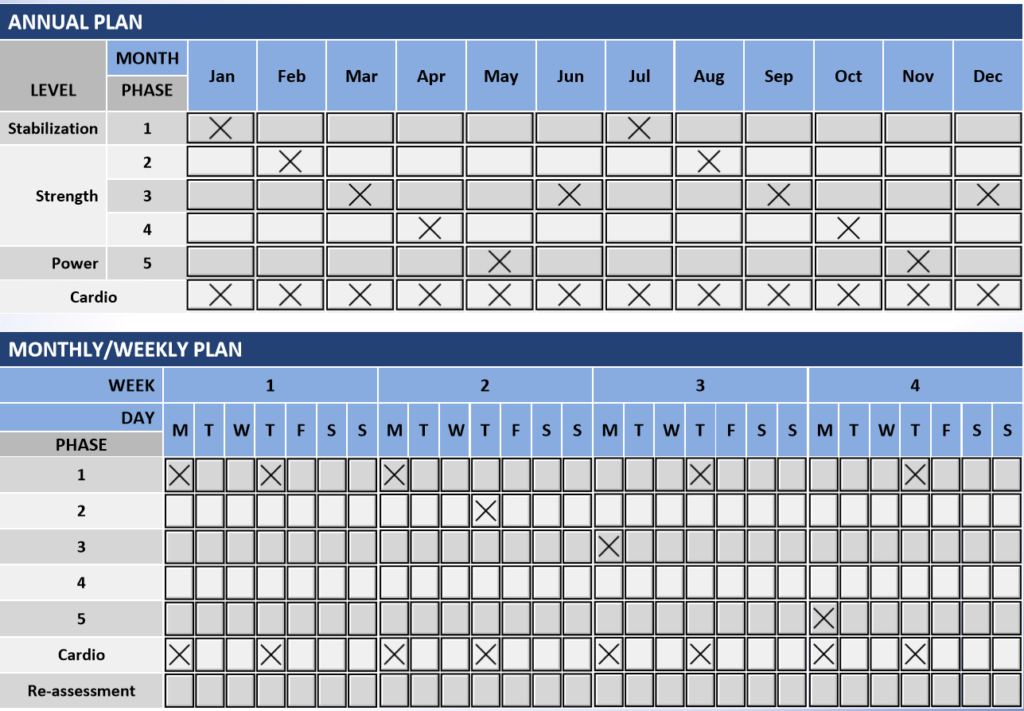Beginning to exercise can be a daunting task. There are many hurdles that a person might use as an excuse to avoid exercise. It is difficult to know what to do, how much to do, how to perform exercises correctly. No one wants to be in pain or get hurt, being unsure about exercises can prevent people from trying something beneficial, or even necessary! Let’s talk about a few fundamentals of starting to exercise.
Where to start:
The first step to beginning exercise is going to be to develop a program. A few things to consider initially are your goals and a realistic expectation of frequency. Whether you’ll be able to exercise 2x, 3x or more per week in conjunction with your goals will determine how you will develop your exercise plan.
It is important to include both cardio and resistance exercises in your exercise plan, each has important benefits and can be performed in a variety of ways. For more information check out Cardio vs. Lifting: the difference and where to begin.
Once you have an idea of your frequency you can determine how to construct your split, organizing body groups on different days to make sure nothing is neglected. If you’re only going to start one or two times per week, a total body split, where each day includes exercises that target the whole body, is recommended. 3x per week or more is a good way to organize individual body groups, chest/back, arms/shoulders, legs. Keep your frequency in the back of your mind as we have to understand a few more things before we make a program and begin.
Muscle imbalances:
Many people develop muscle imbalances. It’s important to understand the general principle of this as it will directly affect the exercises you should perform. Our bodies adapt to stress, and what your brain interprets as stress is broad. Muscles surrounding a joint might become altered if we are overusing some more than others. When this happens our joint becomes dysfunctional and pain related disorders can develop and injury risk increases.
Sedentary people develop imbalances from sitting at a desk for work all day, athletes develop imbalances from overusing the same muscles for their sport, neglecting others. We don’t want to include repetitive cardio that might further increase symptoms of dysfunction, for example, lay off the incline treadmill if you have been getting shin splints!
The assessment:
We want to choose the proper exercises that rebalance our joints. We want to correct muscle imbalances, but overworking muscles that contribute to the imbalance might be counterproductive and exacerbate issues. The best thing to do is to perform an assessment.
Start with the static posture assessment for a reference point, then perform an overhead squat assessment to see what’s really going on. We can also perform a cardiovascular assessment such as the YMCA step test to determine how hard we can push ourselves initially.
Once you perform an assessment you’ll have an adea of some things you need to strengthen and some things you might not want to over-do.
Periodization:
Next, we can look at a systematic way to progress what we are doing safely. We can consult a common method of programming where we alter how we are exercising throughout the year. Changing up how we change every so often is called periodization. Every few weeks we can switch up the way we are training, this is important to avoid plateaus. Constructing your program should begin with a training style that establishes a safe foundation of strength and then progresses through more difficult advanced training styles. Let’s take a look at one common safe progression of training styles:
- Phase one training includes stabilization exercises, 12-15 repetition exercises with lightweight and an emphasis on balance and coordination. Stability ball squats, core exercises with the stability ball, cable resistance exercises on a Bosu ball are examples of how to train in this phase.
- Phase two contains strength-endurance based exercises, 15+ repetition range with moderate weight, removing the stability component. Standard free weight exercises, seated cable exercises, and machine movements are all examples of how to train in this phase.
- Phase three is about developing muscle with a repetition range of 8-12 and moderate weight, focusing on contracting the muscle and controlling the movement. Free weight and machine exercises performed in a steady controlled fashion with high volume are how to approach this phase.
- Phase four, or maximum strength is about developing as much strength as possible. Low repetitions in the 3-5 range, heavyweight and long rests are how to train in phase 4. Large compound movements like squats, deadlifts, and overhead press are the emphasis during maximum strength.
- Phase five is power training. Power training develops speed and explosive power. Plyometric exercises, fast_paced HIIT training, medicine ball work, dynamic cable movements are all helpful to develop maximum power. Light-weight exercises performed as fast and explosive as possible in the 12-15 repetition range is the key to power training.
Periodization program:

Now that we understand how to periodize, let’s take a look at a common way to approach a program with no particular goal in mind other than general fitness. Above,
Exercise selection:
The final step to creating your exercise plan is to select the exercises for your first phase of training. In the Programs section of the website, basic versatile programs can be found for each phase. Corrective exercises are also included to be added to the program you start with. If your assessment revealed certain imbalances, reduce the volume of the exercises that contribute towards the overdeveloped muscles, and include more volume towards the weakened muscles.
Experiment to add or remove exercises based on how you feel, but keep in mind your personal imbalances you are trying to correct! Reassess regularly. As you begin to correct imbalances, adjust the volume of muscle groups back to reflect a move even physique focused on maintenance.



